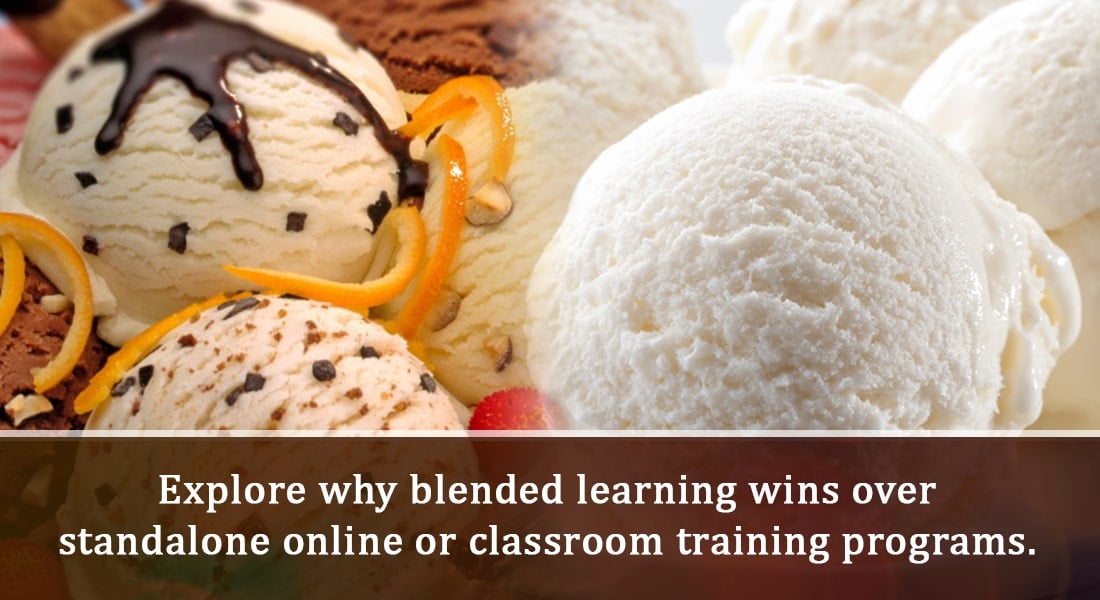Blended Learning: Getting the Best of Classroom and E-learning

According to Dr. Ruth Clark of Clark Training and Consulting, “Distributing learning events over a longer period of time(e.g. 5 weeks) will dramatically increase learning retention compared to compressed learning events (e.g. 5 days).”
So, how do you make sure that your training programs extend for longer periods of time? Classroom training sessions are certainly not the answer. This is because you encounter a number of problems such as increased costs, constraints of logistics and most importantly taking your people out of work for the duration of training.
Then how can you overcome these problems? You may say that self-paced online courses are a solution to these limitations of traditional Instructor-Led Training (ILT). But again, you may face a few issues. Some of your learners may not be comfortable being trained online. The lack of “human touch” can make the training very impersonal. Furthermore, asynchronous eLearning is not very effective in developing soft skills and in cases where hands-on-training is needed.
The disadvantages of classroom training and online courses mentioned above make it clear that no one format can be “perfectly” effective for delivering successful training. It is therefore essential to blend the learning delivery modes to ensure the best training for your workforce. Let us now see the advantages of blending online courses with classroom training programs.
Makes Learning Process Enriching and Active
The traditional format of learning is primarily concerned with the presentation of learning content. Blending eLearning with Instructor Led Training system could make the training lively. A blend of ILT and eLearning adds variety to the training mix and engages learners.
Advances in technology permit the development of courses that incorporate various elements of multimedia such as images, audio, text and videos that add color to the training courses and help your staff learn effectively. You can also include games, quizzes and animations into training.
Combines Elements of Both Formats
It blends the best of both worlds by using a combination of delivery formats or modalities. You can leverage the benefits of effective classroom delivery that results in optimal learning, along with the advantages of a self-paced module to support learners at different phases of the learning process. You can overcome the limitations of one mode with the benefits of the other.
Flexibility Leads to Better Completion Rates
Flexibility in terms of the content and schedule will enable participants not to drop out from course mid-way because they can accommodate the blended solution into their busy schedules without going through much inconvenience. Since they can pace the online component, they can spend additional time on content that needs more attention. Completing parts of the overall training successfully also leads to increased motivation levels.
Blended Learning Is Highly Customizable Learning
Blended solutions allow you to organize your training according to your tailor-made requirements. For instance, if there is a need to provide compliance training for an audience primarily composed of finance staff, who are used to reading a lot of text-heavy content, you can provide pre-course work in the form of documentation that needs to be read up before the course. You can also cut down on the classroom component to the barest minimum by having most of the material online. By increasing the information being covered in the course, you will be able to cover more, in less time, and could reserve the classroom component to just a Q&A session and discussions of critical content. Think of the savings in time and cost! Now the same approach may not work with a target audience of sales professionals who may not prefer to read much content before a session. In this case, you can present the bare information of the content online and follow it up by multiple face-to-face sessions.
We have seen the benefits of blended learning. But how can you formulate the right learning blend? This presentation gives you an idea of the factors that go into the making of the “ideal” learning blend.
Here are a few guide lines and recommendations for designing your perfect blend.
- Move as much of your content online as you can. Depending on the available time for the ILT component, optimize classroom time by making sure that only critical content or learning activities are included in the ILT component. Use eLearning to provide fundamental concepts and pre-training preparation. Later get learners together for classroom learning where advanced concepts, practices and hands-on exercises can be taught.
- Check the organizational culture. If you are very enthusiastic about ILTs but your CLO is keen on moving to eLearning in a major way, see what components cannot be met by eLearning and develop a separate plan for them in your overall blended solution.
- Do not pre-select your learning delivery format without doing a thorough content, audience and task analysis. Maximize the potential of each delivery format.
- Cost is not always the best criteria on which decisions can be based. Organizations are increasingly moving towards blended solutions not in a bid to minimize costs but in a bid to provide the best possible learning solution.
- Get ready for converting most of your existing ILTs into eLearning. Your organization has a wealth of existing resources that can be utilized for your transition to eLearning. Check out a few rapid development tools such as Lectora, Adobe Presenter and Engage, and Captivate to help you convert your existing materials into eLearning. If this skill set is not available, consider hiring experts who can cut down on development time drastically, leaving you to focus on critical components such as needs analysis and evaluation of training solutions. However, a word of caution here – convert ILT into eLearning only if you are able to see real value addition. While you are designing your blended solution, you might also want to re-haul those ILT components you plan to retain.
- Long courses are likely to have more dropout rates. Go with the trend of keeping courses short. Nuggets of information are easier to handle than huge mountains of content.
- Be prepared to alter your course of action. Maybe you had decided on certain content being best delivered by a particular delivery format; however, on closer study of the materials you decided it was not worthwhile. At this point, don’t write it off as wasted exercise – your learners will thank you for keeping them off an ineffective solution.
- Be realistic in your expectations from various groups. For instance, don’t expect your sales engineers to take hours of eLearning courses before they come in to attend classroom training. Knowing their preference, you might want to keep the eLearning component very short so that they can go through these courses on their mobile phones even while travelling and then use the classroom component for advanced discussions. While we are not encouraging that you stereotype your learner groups, we do encourage you to identify core learning preferences that will in turn help you to decide on the best delivery format.
- Use assessments well. Whether you are using ILTs or eLearning, ensure that your learners are assessed at relevant points. The feedback on these assessments might just help them revisit basics that ideally should be available to them at all times. Assessments will also help them see where they stand and which bits of information require more focus. Their feedback to you will also prove to be valuable in further improving your learning solutions. An increasing trend, especially in the case of standard trainings such as compliance trainings, is to move all assessments online.
- Don’t camp around past victories. In an attempt to arrive at the right formula, we might be tempted to repeat the exact strategy we followed in the past that was successful. Do remember that your audience, content and learning goals vary, so that your solution cannot be blindly applied.
Thus, by blending learning delivery formats, you can provide comprehensive training to your people and get better value for your training dollar. What do you think? We’d love to hear your views.





![Blended Learning for Corporate Training: Overcome 3 Implementation Challenges [Infographic]](https://blog.commlabindia.com/hubfs/Imported_Blog_Media/blended-learning-implementation-challenges-solutions-info-v1.jpg)